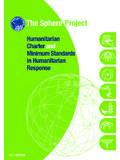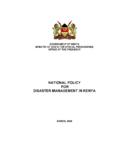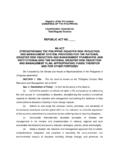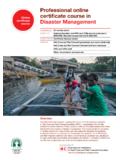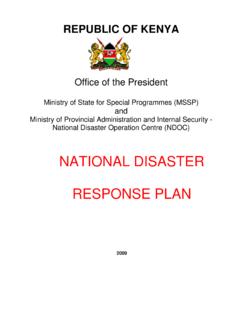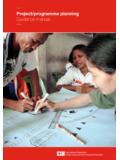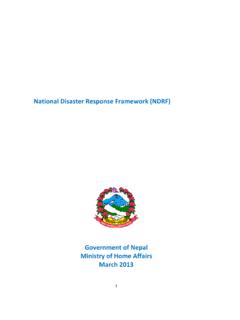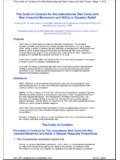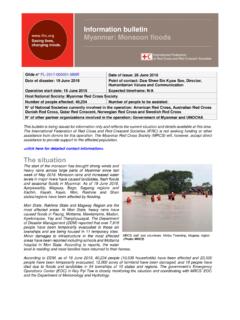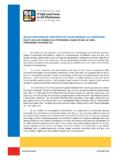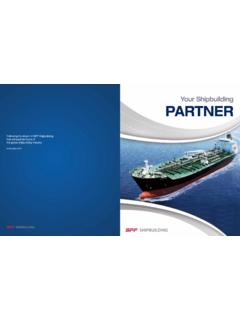Transcription of The road to resilience Bridging relief and sustainable future
1 The road to resilience Bridging relief and development for a more sustainable futureIFRC discussion paper on resilience June lives, changing minds. International Federation of Red Cross and Red Crescent Societies, Geneva, 2012 Any part of this publication may be cited, copied, translated into other languages or adapted to meet local needs without prior permission from the International Federation of Red Cross and Red Crescent Societies, provided that the source is clearly stated. Requests for commercial reproduction should be directed to the IFRC at photos used in this study are copyright of the IFRC unless otherwise indicated. Cover photo: Romulo Godinez/Philippine Red Cross.
2 It is vital to increase the participation of all in the development process through initiatives including meaningful voluntary service and strong social Box 372CH-1211 Geneva 19 SwitzerlandTelephone: +41 22 730 4222 Telefax: +41 22 733 0395E-mail: site: 06/2012 The road to resilience E 2 000 Strategy 2020 voices the collective determination of the IFRC to move forward in tackling the major challenges that confront humanity in the next decade. Informed by the needs and vulnerabilities of the diverse communities with whom we work, as well as the basic rights and freedoms to which all are entitled, this strategy seeks to benefit all who look to Red Cross Red Crescent to help to build a more humane, dignified, and peaceful the next ten years, the collective focus of the IFRC will be on achieving the following strategic aims:1.
3 Save lives, protect livelihoods, and strengthen recovery from disasters and crises 2. Enable healthy and safe living 3. Promote social inclusion and a culture of non-violence and peace1 International Federation of Red Cross and Red Crescent SocietiesThe road to resilience Table of contentsIFRC discussion paper on resilience June 2012 Table of contentsForeword by Matthias Schmale, Undersecretary General of the IFRC 3 Implications for policy and action 4 Introduction 61. What is resilience 72. How to strengthen resilience 133.
4 Characteristics of resilient communities 17 Conclusion 27 The purpose of this document is to present to our key partners the IFRC s definition of and perspectives on resilience . It also serves as a reference across the network of National Societies. We invite all key stakeholders to support the Red Cross Red Crescent s operational work on resilience so that together we can bring about the serious changes needed for sustainable development in the years Federation of Red Cross and Red Crescent SocietiesThe road to resilience Section subtitleIFRC discussion paper on resilience June kid in little boy will need to have his vaccinations up to date against preventable diseases, a mosquito net, health services accessible if he falls ill, a home, a school, healthy food, clean and safe water and a secure environ-ment to grow in with dig-nity like you and me.
5 If he gets all these basics, he will be able to grow and develop beyond mere survival. Benoit Matsha-Carpentier/IFRC3 International Federation of Red Cross and Red Crescent SocietiesThe road to resilience ForewordIFRC discussion paper on resilience June 2012 Since its creation, the Red Cross Red Crescent has been guided by a clear set of humanitarian principles and values that aims, in one way or another, to effectively contribute to building resilience . We strive to meet people s basic needs for health, shelter, education, food, water and security; make every effort to ensure that the social costs and benefits are fairly shared by all and inequities are eliminated; that human rights, human dignity and local values are understood and respected.
6 And to ensure that non-renewable resources, biodiversity and the environment are managed the Rio+20 Summit marks the 20th anniversary of the 1992 UN Conference on Environ-ment and Development and the 10th anniversary of the 2002 World Summit on sustainable Development, the Red Cross Red Crescent offers these reflections on resilience and calls upon key stakeholders to work as partners with us to facilitate sustainable development and resilience . We see resilience as the ability of individuals, communities, organisations or countries exposed to disasters, crises and underlying vulnerabilities to anticipate, reduce the impact of, cope with, and recover from the effects of adversity without compromising their long term address social and economic determinants at different interconnected levels individual, community, national, regional and global.
7 It is important to understand how individuals well-being can have an impact on their ability to contribute to the development of the community in which they live. Community development is dependent on government policies and market forces. These, in turn, depend on regional and global governance, demographic trends and universal trends such as ageing, urbanization, increased global connectedness, climate change and pandemics, to name but a few. It is vital to increase the participation of all in the development process through initiatives including meaningful voluntary service and strong social capital. The Burundi example in this document illustrates the value of our grass-roots network in building community resilience : a visible, widespread impact on communities resilience in the face of the potential risk for future ethnic violence, current and future food insecurity and the challenges of inadequate community services.
8 We are known for our vital relief work in disasters and crises, and we remain committed to be the world s leading humanitarian actor. At the same time, the Red Cross Red Crescent is not just active during disasters; we are also present in communities before disaster strikes and work well beyond the initial crisis phase. We are well-placed to contribute effectively to development. Changing minds, attitudes and ways of working towards strengthening resilience , equity, and dignity is achievable when we work together to build bridges across established divides. We look forward to doing more of this with all our key Schmale,Undersecretary General,International Federation of Red Cross and Red Crescent SocietiesForeword4 International Federation of Red Cross and Red Crescent SocietiesThe road to resilience Implications for policy and actionIFRC discussion paper on resilience June 2012 Risk Reduction and strengthening resilience are critical elements in promoting sustainable development and should be part of the international development agenda beyond 2015 (post Millennium Development Goals).
9 In this respect we are fully supportive of the commitment governments made at the 4th High-level Forum on Aid Effectiveness held in Busan in 2011 to ..ensure that development strategies and programmes prioritise the building of resilience among people and societies at risk from shocks, especially in highly vulnerable settings such as small island developing states. Investing in resilience and risk reduction increases the value and sustainability of our development efforts. 1 It follows that risk reduction must be integrated into public investments policies and planning. Risk assessments, based on analysis of loss and estimation of po-tential future losses, are essential for informed decision-making.
10 Governments, policy makers and other relevant key stakeholders should encourage the develop-ment and financing of plans for resilience in a coordinated and coherent manner across sectors. Disaster laws facilitate the strengthening of resilience and community engage-ment, and governments are encouraged to establish and/or update relevant di-saster management legislation. Governments should ensure fair and lasting energy solutions that put vulnerable and poor people first and help cut greenhouse gas emissions. At international level this should include new financial and technical support to efforts of devel-oping countries to provide the full range of energy services needed to help pull people out of All involved actors must work in global and local partnerships to strengthen resilience including to enact necessary reforms of governance at all levels; to strengthen accountability, as well as citizen monitoring of environmental and de-velopment performance at all levels.
